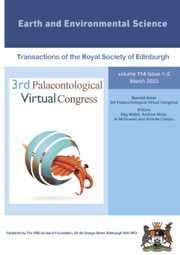No CrossRef data available.
Article contents
Tempo and mode of skull size evolution in Temnospondyli (Tetrapoda: Amphibia) and lineage diversification in the largest group of early tetrapods
Published online by Cambridge University Press: 20 October 2025
Abstract
The evolution of skull length in temnospondyl amphibians is investigated using a variety of phylogenetic comparative methods applied to a time-calibrated supertree of 288 species. Temnospondyls expressed greater among-group than within-group variation in skull dimensions, pointing to a rapid occupation of distinct regions of trait space early in their history and during major episodes of clade diversification. Consistent with this pattern is the occurrence of regime shifts along basal branches in their phylogeny, especially within a diverse clade consisting of dendrerpetids, dvinosaurs, zatracheids, and dissorophoids. An additional conspicuous shift marks the separation between the two main clades of derived stereospondyls, the trematosauroids and the capitosauroids. Mean skull length differs significantly among taxonomic groups and across three main time intervals (Carboniferous; Permian; Mesozoic). However, the distribution of skull lengths across groups varies from nearly symmetrical to markedly skewed. Despite these differences, analyses of skewness show that the evolution of skull length conformed for the most part to expectations of a driven trend, with a sustained and directional pattern of change mirrored across separate lineages. Trait values and evolutionary rates tend to increase through time across the entire group, but individual lineages show contrasting patterns, revealing either no temporal trends or varying degrees of increase/decrease through time. Reduction in skull length features predominantly in terrestrial groups, such as amphibamid dissorophoids, although exceptions are observed. In contrast, most groups exhibiting an aquatic lifestyle tend to attain large or even gigantic sizes, particularly among stereospondyls.
Information
- Type
- Spontaneous Article
- Information
- Copyright
- © The Author(s), 2025. Published by Cambridge University Press on behalf of The Royal Society of Edinburgh


